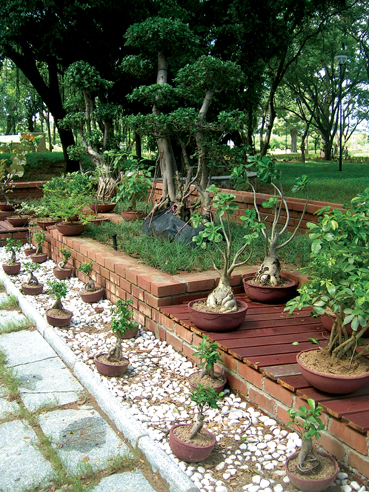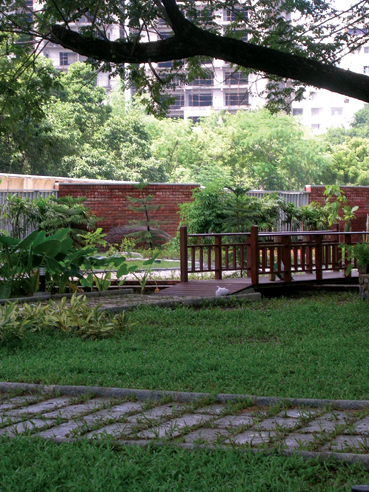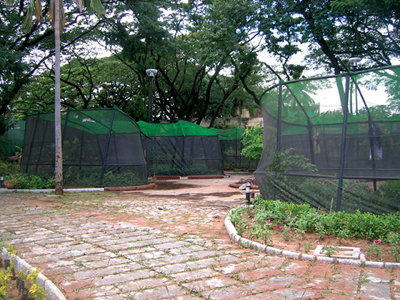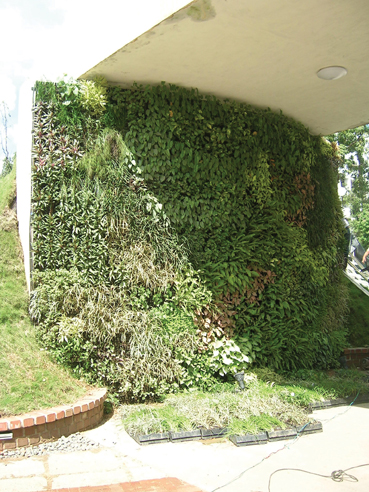|
The refreshing aroma of freshly cut grass and watered gardens and the sights of aesthetically laid out flower beds and vibrant orchids greet you as you step in the city’s newly created botanical gardens, the Semmozhi Poonga. Here, surrounded by lush greenery and rejuvenating water bodies, it is hard to believe you’re in the heart of a metropolis.
 |  | The bonsai garden. | The cross-over bridge. |
Driving along Cathedral Road you get a view of the transformed site that has been cocooned away from the city surrounded by its thick green cover for the past year. Once the Agri-Horticultural Society’s green lung and home to the erstwhile Woodlands Drive-In Restaurant, the site has witnessed a complete makeover. As you enter the premises, nostalgic memories of past experiences fill your mind instantaneously.
 |  | The butterfly garden. | The vertical garden. |
Walking through the unfinished gateway, I see a swarm of workers toiling to fix the large monolithic rock signage which is to have the name ‘Semmozhi Poonga’ as written on it by the Chief Minister when he inaugurates the park on November 24th. Red tape glitches aside, in a year’s time from now, the park promises to be a place every Chennaiite can take pride in.
A large arbour forms the main entrance and it has a vertical garden with over 7,000 tissue culture plants of 35 different species adorning it. A few steps from the arbour is a ticketing counter, also under construction. A stone-laid pathway leads to the main garden sprawled across seven acres.
Vijay Ram, the Government horticultural officer in-charge, briefs me on this highlight of the park. He says the concept of the garden developed after a study on the micro-climatic conditions of the city. “The first of its kind in the city,” he points out and adds, “this garden is home to as many as 22 different types of gardens, four fountains, a pond, cascades, an open air amphitheatre, info centre, a children’s play area and food court. The aim is to create a completely different experience for the people of Chennai.”
The pathway leads you to the much talked about, beautifully pruned bonsai garden that has cacti imported from China. The flowering and non-flowering varieties of cacti are in the 2-40 year age group. The neighbouring palm and cycas garden houses five species of cycas plants and various palm species, such as the red palm, sun palm, red lantern, and blue and yellow palms. Freshly planted, the cycas varieties seem no different from each other but, once fully grown, they promise to add colour to the green monotony that flows throughout the garden as of now.
The landscapers point out that the major challenge faced by them was that of having to work around the existing layout of the site. “The garden has relatively less colour and as such we had to bring in more shade-loving plants. We had to carefully develop areas around the existing trees that are over 100 years old,” says Saravanan, Director, Sri Green Makerss, landscape contractors for the project. He also tells me that “shafts created out of 14 different bamboo species outline the periphery of the botanical garden, sheltering it from the traffic and the pollution.”
Jade plants, orchids and the Nephanthes rafflesina, an insect-eating plant, are perched on the existing trees, adding some colour to the otherwise green foliage. A large pond bordered with football lilies is a welcome cool retreat in the garden. A wooden gazebo constructed by the pond aims at creating a soothing ambience.
Next on the trail is the fern garden housing 30 different fern species and an exotic garden containing rare species such as the golden barrel cacti, Podocarpus, Sterculia etc. “A herbal garden, and an aroma garden that includes roses, lavender and jasmines, among other sweet-smelling varieties, are to be added to the array of gardens already flourishing,” says Saravanan.
Two crossover bridges lead you to the open-air amphitheatre that has a seating capacity for 300 persons and will be open for flower shows and other public events. A water cascade will run through one end of the garden and eventually flow into the pond – but that’s yet in the future.
As I walk along, the hugely netted, wing-shaped butterfly garden is hard to miss. In the adjoining rock garden are 25 varieties of rock plants. The food court is still under construction and the brightly coloured children’s play area looks freshly painted, but doesn’t seem to have had any major change from the earlier playground at Woodland’s. The neighbouring Golden Garden with its newly planted seedlings currently reflects a shade of pale yellow. Like most other sites, it too is expected to keep its promise in time, in this instance turning golden, when its carefully picked plant types, such as the Yellow Queen and Bird of Paradise, are in full bloom.
“Another attraction of the garden is the sequential fountain that will display 24 fountain patterns changing every 90 seconds. The info centre will also function as an interpretation centre that will house presentations and educative material for the general public. A public sound system for the entire garden is on the cards too,” says Vijay Ram.
The fruits of ten months of labour by 200 migrant workers, this Rs. 7.2 crore project is set to enhance the city’s green cover. “Creating a garden in a prime location is aimed at educating the public and sensitising them towards valuing our ecology. Instead of whiling away time at malls, people should visit this garden and appreciate nature in all its glory,” urges Vijay Ram. The garden will be open round the year, though there will be an entry fee.
|